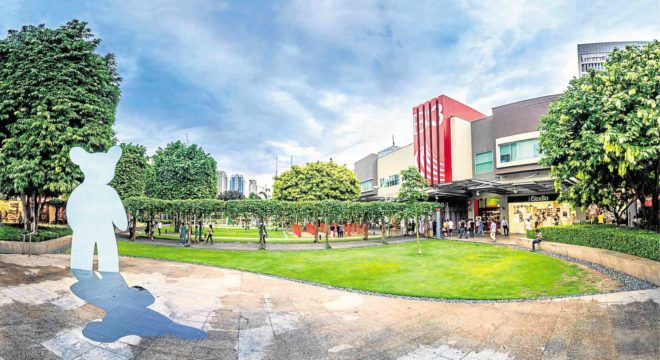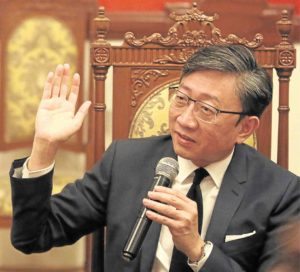

In the mid-1990s, Taiwanese architect and urban designer Sean Chiao and his company were tasked to change the original master plan of Bonifacio Global City (BGC). When he emphasized the vision of a walkable environment and a landscape-centered city, Chiao drew flak from the locals.
He recalled being told: “You’re not from the Philippines. Filipinos don’t need streets and sidewalks. They want to go to shopping centers. It’s hot. Nobody wants to go outside!”
But then he explained: “People turn to shopping malls because there are no parks.”
Chiao, president of the international urban planning and engineering firm Aecom Asia-Pacific, worked with the Bases Conversion Development Authority (BCDA) and Ayala Land to develop BGC—with Bonifacio High Street (BHS) as the centerpiece.
Original BGC design
Aecom’s original design made provisions for the growing population density. In the ’90s, there were discussions about a rail transport along C-5 with a depot in BGC. Parking structures were positioned along BGC’s peripheries.
Hence, people would have alighted from the train or their vehicles and walked toward the city center.
Covered, elevated walkways were intended for people to cross buildings while being protected from the weather.
“The infrastructure, the North Rail Transit, the peripheral parking buildings and skywalks didn’t happen. I don’t know why,” Chiao said. “The proposed supporting infrastructure to support the growing density was not implemented. We weren’t creating bottlenecks. BGC was not built entirely according to our plan.”
Nonetheless, Chiao pointed out that BGC is still a benchmark in designing new cities in the Philippines: “It has proven to be one of the most enjoyable environments in Metro Manila. BGC is distinguished by its sidewalks, the trees, the arcades and outdoor cafés.
“People want to be part of the transition between the outdoors and indoors. They go to malls because there is a lack of open spaces or healthy environments for them to stay outside. If you provide shades and trees, they will find the outdoors more comfortable. Nobody wants to stay indoors for 24 hours.”
He added: “Twenty years ago, there was no BGC. The Fort was uninhabitable. The redevelopment has increased activity and land value. When people are inspired by good design, they can see that things can be done in a certain way.”
Centralized green space
Chiao has been coming to the Philippines for 22 years to work on BCDA projects such as the Clark Green City and Ayala Land’s BHS, Ayala Triangle Gardens and the park city of Nuvali. Both Aecom and Ayala Land have adopted the centralized green space as their model.
On a recent visit, Chiao brought a team from the Harvard Graduate School of Design (GSD), his alma mater, to study the city of Manila and how it can be regenerated.
“AECOM works with Harvard GSD to initiate dialogue and to provoke,” Chiao said.
He then referred to the City Beautiful Movement, which, in the 19th century, initiated urban planning and more breathing spaces, and how it dignified surrounding buildings.
It urged citizens to be more concerned about their cities, which were slowly decaying due to rapid urbanization and population growth.
“The City Beautiful Movement means citizens should support and tell the government, ‘We deserve a better living environment,’” Chiao said.
He then quoted Harvard GSD Mohsen Mostafavi, who said that Metro Manila needed basic maintenance to build dignity for its citizens.
Frequently asked how Metro Manila has changed since he first came here in the ’90s, Chiao said: “The feeling is the same. Edsa is still congested despite the MRT. On my way here, I see pollution, garbage on the road and dilapidated storefronts.”
When he visits exclusive, gated communities and mixed-use complexes, he feels like he’s in another world. The pleasure is jarred by the sight of slums between the communities.
“In the middle of a high-density area is a utopia or an unrealistic environment,” he said. “There is a disconnection, a lack of coordination. That is why traffic becomes congested. There is a lack of public transit, a comfortable environment for walking and bicycles, and open spaces. People aren’t living and working in a livable, planned environment.”
He added: “Powerful leadership is important. If you lack strong governance, it’s hard to connect all these things together.”
‘River of Life’
Chiao cited the example of the River of Life (RoL) Project, which revitalized the Klang and Gombak Rivers in Kuala Lumpur, as an economic initiative of the government. The New Straits Times reported that Malaysian Prime Minister Najib Razak spearheaded the program by ordering a vigilant cleanup campaign, underscoring the need to preserve the rivers as Malaysia’s heritage.
Razak emphasized the RoL project would have a powerful impact on Malaysia’s progress and improve its quality of life.
“The river is beautiful but because of pollution, people abandoned it,” Chia said. “The city turned its back on the river. Once you clean up the river and open up the front, the city can flip to experience the change. The land use changes with public transport connected to it. Commercial, residential and food and beverage elements come along, making the river the living room of the city. It’s not just about a river, but a spine to connect the body of the city.”
Another example is the Singapore River. In the morning people jog and stroll along the riverfront. In the evening, they enjoy the nightlife and hold festivals. Antique shops, restaurants and a landing area for the Raffles Hotel line the riverfront. It also threads landmarks, temples and ports.
“People are proud of the place,” Chiao said.
Think different
On the Philippine government’s Build, Build, Build program, Chiao said: “People should think differently about infrastructure. It’s not only about roads and trains, but dealing with issues of water, public transportation, public spaces, and connectivity. The framework should be coordinated between each piece of land.
“Infrastructure isn’t just about highways but also rivers. Cities along the Pasig River should form an organization where everybody owns that. Form a redevelopment authority to clean it up. Once it’s clean, then you can do business with walkways, shops, restaurants—connect it to the city and build parking. The cities along it can be revitalized.”
Moreover, infrastructure involves transit-oriented development. Chiao cited land development along train stations in Hong Kong and Singapore, which he described as “convenient and high urban density-friendly.”
He added: “Don’t just build subways and trains. Every station needs to be planned. As you come out of the stop, there are shops, restaurants and hotels. Use that money to pay for transit. The investment to build the transit is never recovered from ticket sales. That’s the rule throughout the world.”
Chiao also noted the trend of aerotropolises—airport cities with commuter-linked suburbs and surrounding businesses that are related to the airport. Visitors don’t have to go to the city proper if hotels, retail spaces, a convention center or a business park are close to or inside the airport.
Green city
Aecom is likewise working on Clark Green City, with Budji Layug + Royal Pineda as local partner firm and BCDA as client.
Unlike BGC, which is more a financial district, Clark Green City’s 9,450 hectares will include all the fundamentals needed for a city aside from residential, office and retail spaces. It will be built with government offices, sports stadiums and facilities, healthcare facilities, schools, light and heavy rail transits, and connections to the airport.
“Clark is a government activity that’s 40 times bigger than BGC,” Chiao said. “It needs a holistic approach. As a sustainable city, the use of water and energy can be monitored for efficiency. It can have driverless cars and be a smart city. Fundamentally, this is a place to design for people, not cars.”
Chiao pointed out that design professionals can see the potential of a city. However, ideas are only as good as when clients are committed.
“Aside from a good plan with integrated solutions, strong government is needed,” he said.
Media and citizens can demand a better quality of life for themselves, Chiao said. Politicians can use urban revitalization and holistic infrastructure projects as a platform in their next campaign.
“Good design brings business,” Chiao asserted. “Revitalization is not limited to a district. A city isn’t beautiful if there are slums between the district. See the city from a bigger picture, and fix that connectivity.”–CONTRIBUTED

